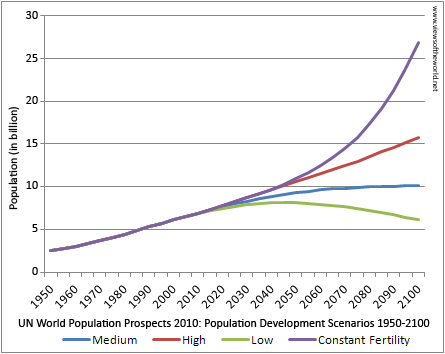I haven't finished the post yet but here's what I've got so far.
So how do we go about stoping and reversing climate change? We'll start by using the goal Glenn gave in this thread of reducing our carbon foot print by 40% by 2050 and the IPCC goal of 100% in 2100.
To effectively analyze this issue we need to know three things:
- How much power per capita do we need by 2050 and by 2100
- Is there mix of power that could realistically reduce and eliminate our CO2 emissions
- How much CO2 needs to be pulled out of the air to reverse MMGW
Our carbon footprint for the most part is tied to the global population, mix of power sources, and standard of living expressed in terms of kWH per person per year. Reduce any of these and our carbon foot print goes down.
Now the green extremists don't seem to care about people or standards of living as long as the environment is protected. The conservative extremists don't care about people or protecting the environment if it reduces profits/economy. While both extremes are just opposite side of the same crazy coin there is a kernel of truth in each. The environment needs to be protected
because we need it. The economy also needs to be protected
because we need it too.
So my goal is to find a solution that simultaneously maintains or raises the standard of living while reducing our carbon footprint.
The only way I see to do that is to reduce the future population of the planet. The only way to do that ethically and morally is to increase the standard of living in the third world so birth rates drop and global population declines.
To increase the standard of living the number of kWh per person per year must increase. To do that while simultaneously reducing our carbon foot print before the population begins to reduce means significantly changing our mix of power sources.
To answer this question we need to know whether it's possible to reduce global population through standard of living and are there alternative power sources that could reasonably displace coal, oil and natural gas.
First up global population. From UN projections we are looking most likely at slowing growth but still peeking at 10+billion by 2050.
The breakdown shows that most of the gain is coming from developing nations. Developed nations actually have slowly declining or stagnating populations:
When looking at the break down by country, the countries with the highest birth rates also have some of the lowest kWh per person per year.
List of Countries by Birth Rate
Table of Countries by kWh per capita per year
For example:
Ethiopia has a rate of natural increase (birth rate - death rate) of over 32 but only 52 kWh per person per year
Italy on the other hand has a slightly negative rate of natural increase of -1.26 and over 5500 kWh per capita per year.
So the question is:
If we assume that by taking action to raise 3rd world quality of living we'll hit the lower peak population of ~8.5billion in 2050 how many kWh do we need to raise everyone up to 1st world quality of living while replacing 40% fossil fuel usage.?
Assumption 1: 1st world quality of living standards (~ Italy@ 5500kwh/person year) will let us reach the lower predicted global population
Assumption 2: Efficiency gains of 10% will be available by 2050 lowering the total kWH per person year required by ~ 500kwh/ person year for the third world
Assumption 3: There are currently 6 billion people in the third world with an average 1000kwh/person year who will need another 4000kwh/person year to reach 1st world quality of living
Assumption 4: 1.5billion new people in the third world need 5000kwh/person year in 2050 to reach 1st world quality of living
So for new generation we need:
6billion people x (4000kwh/person year) + 1.5billion people x (5000kwh/person year) =
3.60TW or 31.5trillion kWH per year in additional generation in 2050
In 2014 the world used about 17TW of power or 1.496x10^14kWh/year
Split as follows:
- Petroleum: 5.75TW
- Coal: 5.12TW
- Natural Gas: 4.11TW
- Nuclear: 0.82TW
- Renewable: 1.37TW
So to hit the target of 40% reduction of emissions by 2050 we need to replace:
.4 x (Coal + Natural Gas + Oil) =
5.96TW or 5.2X 10^13kWh/year
Total new clean power generation required for 2050 (40% fossil fuel replacement + new generation)= 5.96TW + 3.6TW =
9.56TW or 8.37 X 10^13 kwh/yr
Let's take a look at 2100 and see what it would require to get to 0 fossil fuel usage.
Assumption 5: With the third world now at 1st world standard of living assume a reduction to 6Billion people by 2100
Assumption 6: Another 10% efficiency gain is possible by 2100.
So to calculate the required clean power generation let's take the total power required in 2050 with 8.5billion and scale it down to 6billion and take another 10% off:
(17TW +3.6TW) (6B/8.5B)(.9)=
13.1TW Total clean generation in 2100
Now in 2050 we are already generating 11.75 TW cleanly
so by 2100 we only have to generate another:
1.33TW
Population reduction means over 6TW of fossil fuel generation can be removed. Leaving only the 1.33TW to be covered by clean generation.
Next up how feasible is it to generate this energy cleanly.
For the purposes of this post I'm going to look at two of the most obvious clean options:
We'll also assume that fossil fuels for transportation can be replaced by battery electric, fuels cell, or carbon neutral bio/synthetic fuels by 2100.
Nuclear - Pros & Cons:
Nuclear fission is clean from a greenhouse gas perspective as nothing is burned. It's also incredibly power dense compared to other common power sources:
- Natural Uranium (.7%U235) in a LWR - 443,000MJ/KG
- Reactor Grade Uranium (3.5%U235) in LWR - 3,456,000MJ/KG
- Natural Uranium in a Breeder Reactor - 86,000,000MJ/KG
- D-T Fusion - 576,000,000MJ/KG
- Oil - 46.3MJ/KG
- Coal - 32.5MJ/KG
Nuclear fission, depending on the process, releases 10,000 to 100,000 times more energy in a light water reactor than oil; 2 million times more in a breeder reactor.
In section one we calculated that by 2050 we would need 9.56TW of clean energy with an additional 1.33TW by 2100.
How much Uranium would that require?
In 2013 world wide nuclear power production was 364GW
(link).
To generate that the industry used a block of Uranium 14.5m/side:
To generate all the power required in part one in 2050 we would need about 28 of those Uranium blocks per year.
By 2100 we would need about an additional 4 blocks for a total of 32 blocks of Uranium.
If instead of light water reactors, breeders were used, a single block could generate 5 times more power than is required in 2100.
For comparisons sake this the size block of oil produced in 2013:
So the pro's are it's entirely possible to generate the required amount of power needed with no more uranium mining required than we already do.
The cons are how many new reactors are needed and the risk from the waste. The use of breeders can significantly reduce that risk by continuing to "burn" the waste as fuel reducing the amount of waste and drastically shortening the storage requirements.
There are some great designs for small modular reactors in the 10MW-50MW size that could be good for developing countries. Designs would need to take proliferation into account.
(link)
Solar Pro's and Cons
Solar is another and complimentary option.
The Earth intercepts ~ 2x10^17W of solar power. This is about 20000 times more power than we need in 2100. Hypothetically it could supply all the power we would ever need.
Let's make some assumptions and see what would be a reasonable amount of solar power to generate from a low cost third world country solution.
Assumption 1: For developing countries assume fixed solar arrays that point south, in the Northern Hemisphere and north in the Southern Hemisphere. Tracking arrays are more efficient but can break down. Fixed arrays can just be set up and left.
Assumption 2: Let's assume a 10m^2 array per person, (roughly 10ft by 10ft).
Assumption 3: Per this site, which unfortunately has changed significantly since I started investigating this,
(link) let's assume that the average yearly US solar insolation of ~5kwh/day for a fixed array pointed south at latitude is a good proxy for anywhere in the world.
Assumption 4: Assume the average efficiency of a mid-late 21st century solar array is ~ 25%. (The ISS arrays designed in the 80's are in the teens, stuff coming out the labs today are max at 40%).
kwh/person year = 5kwh/day x 365days x .25 = 456kwh/year
Or
.442TW per year
While that's a 50% increase above the baseline of 1000kwh/person year for most of the third world today it's only about 5% of the 9.56TW power we are looking for by 2050.
To completely replace the rest of the power we calculated for 2050 using the best solar arrays at 40% efficiency, dual axis sun tracking, and in the sunniest places around the word like the American Southwest
(link), we get about
12kWH/m^2 per day x .4 x 365days
=1752 kWH/m^2 per year.
(9.56TW per year - .442TW per year) x (1 / 1752kWH/m^2 per year) =
46,000 km^2 worth of arrays.
Or
A square 213km on a side.










